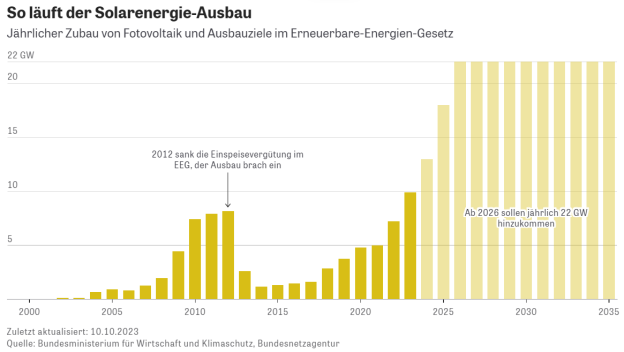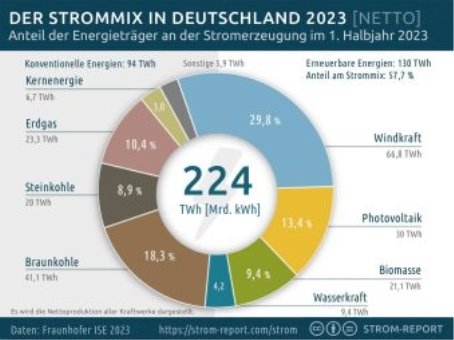The term of „Energiewende“ (German for “energy transition”) is getting more and more widespread nowadays. It appeared in 1980 and defined an alternative way to produce and use energy. It has been planned that by 2050 Germany will have reached “fully sustainable energy production” [8]. Some of the sources used for renewable energy production are solar and wind power — they are called “renewable energy sources” or RES. However, after more than 40 years of changes Germany started to face several problems, e.g. price burden for consumers [11]. In this case, the question arises, whether Germany will be able to achieve all the goals set for renewable energy? Does it use the wind and power resources available competently? In this essay I am going to expand on the problems of German usage of wind and solar energy and speculate about its perspectives.
By now Germany already produces 56–63 % of its energy from renewable resources like wind, water, solar and biomass [14], [Fig. 2]. But it wants to reach the level of 80 % by 2050. According to the Institute for Applied Ecology, the energy from photovoltaic and wind costs only 5–6 cents/kilowatt. It is already lower than construction of conventional power plants [7].
Currently, Germany is 33 % ahead of the plan in building new solar power plants and is lagging behind for 23 % in the construction of wind power plants [Fig. 3]. It already receives 2 gigawatts of energy from wind power plants and about 10 gigawatts from solar ones [Fig. 4], [Fig. 5].
However, everything has its disadvantages. German people pay the highest bills for electricity — their renewable energy surcharges keep growing from year to year [11]. As of 12.10.2023, the cost of electricity in Germany is 28,7 cents for new users [14]. There are more than 300.000 consumers with shut off electricity due to the unpaid bills. Even if social guarantees are paid, they are used to pay for the growing cost of electricity.
Moreover, renewable energy sources are not the most reliable ones, as they depend on many factors that are not related to people’s activity. Windy and sunny places need to be chosen very carefully. As for 2021, the most of Germany’s windmills are located in the Northern part of the country next to North and Baltic seas with strong winds [Fig. 6]. If there is a scarcity of green energy, power plants which use traditional sources are put into operation, what affects the bills of consumers in a negative way. The government has already instructed the federal lands to allocate areas for the construction of windmills. However, it is very difficult to find such free areas which has caused resistance in some governments.
Manufacturers can barely cope with the grandiose plans of the government. While the share of the necessary supply of Germany with energy from renewable sources is growing, manufacturers have neither time nor enough workers to meet the growing demand. A good example is the situation around 50 Hertz, a network operator in eastern Germany. Due to numerous inspections, the company was able to start construction of a strategically important site only after 17 years [15].
One more factor is that Germany itself does not have enough sources to cover its needs for energy production. That is why it depends on the import of sources — gas, wood, oil. Since the beginning of SMO, Germany has been striving to abandon Russian gas as fast as possible. Though, in July after decommissioning of nuclear power plants, Germany has increased its import of energy and it costs her 3 times as much as the export prices — 97,20 and 38,60 euro dollars respectively.
If Germany wants to completely abandon non-renewable energy sources, then it should increase the share of energy received from RES. Last year, wind energy provided about a quarter of all energy, solar energy — about 12 % [1], [3]. However, Germany plans to increase the number of solar and wind power plants. In the future, Germany wants to increase the amount of energy from wind for 65,8 gigawatts and for 30 gigawatts from the sun every year starting from 2026 [Fig. 7]. It seems to be highly doubtful that Germany will be able to achieve such results in the nearest future due to the political situation and the overdue energy crisis.
Considering all the facts mentioned above, I might speculate about the future of German renewable energy sources usage.
Firstly, Germany is said to be a country with high potential in the energy transition using renewable sources of energy such as wind and solar power. It has relatively favorable geographical conditions for the development of green energy — Nordfriesland, Schleswig-Holstein and other coastal regions are suitable for the development of wind energy while the largest solar parks are located in Brandenburg and Bavaria.
No doubt, that every technological innovation tends to create new workplaces. And Germany is no exception. Workers previously employed at nuclear power plants or coal mines may be retrained or retired earlier. There will be a strong need for highly specialized personnel to create and maintain solar park, windmills etc. The government also plans to reduce the time needed for permitting processes to build solar and wind power plants — from several years to several months.
There is still a need for conventional sources of energy — when there are few sunny days or wind is not strong enough to cover all the needs. Concerning the statistics [Fig. 1], Germany still gets approximately 10 % of energy from gas and 30 % of energy from coal, though its last mining site was closed in December 2018. Germany does not require such amount of energy sources, so it has to import them. In 2022 Russia remained the biggest coal supplier for Germany together with RSA and Columbia [12]. But due to the current geopolitical situation, Germany has announced a plan of getting rid of Russian energy sources. I assume that Germany will try to look for new suppliers of energy sources. For this reason, possible partners might be South Africa, the Netherlands, Norway, the USA or UAE.
However, I assume that the vector of the German transformation will shift towards green hydrogen. It is said to be more eco-friendly with “negative” CO 2 emission [13]. Germany has already signed an agreement with UAE about the production of green hydrogen and constructed green hydrogen production centers in several African countries. It invests in another countries’ green transformation to secure future fuel supplies. If Germany continues to stimulate the development of Africa, the country will even be able to see a new partner in its face.
To sum up, Germany is confidently moving towards abandoning non-renewable energy sources. Although there are problems of a bureaucratic, geographical and political nature, I am sure that Germany has a great potential. I doubt that Germany will place much emphasis on the construction of solar and wind power plants, since it immediately considered them only as means of transition. Anyway, solar and wind power together make up 43,2 % of all energy sources with wind power being the most important one and solar energy on the 3 rd place [Fig. 7]. In addition, demontage as well as construction of such power plants costs a lot of money. If Germany can overcome the energy crisis associated with the sanctions imposed against the Russian Federation, then it might be able to achieve its goals in energy transition using green hydrogen as the main source of energy.
Annex

Fig. 1. Electricity production in Germany by energy sources, monthly values
Source: https://www.zeit.de/wirtschaft/energiemonitor-deutschland-gaspreis-spritpreis-energieversorgung

Fig. 2. Share of renewable sources in total electricity generation in Germany, monthly values
Source: https://www.zeit.de/wirtschaft/energiemonitor-deutschland-gaspreis-spritpreis-energieversorgung

Fig. 3. The number of wind and solar power plants in Germany, monthly
Source: https://www.zeit.de/wirtschaft/energiemonitor-deutschland-gaspreis-spritpreis-energieversorgung

Fig. 4. Annual expansion of onshore wind energy and expansion targets in the Renewable Energies Act
Source: https://www.zeit.de/wirtschaft/energiemonitor-deutschland-gaspreis-spritpreis-energieversorgung

Fig. 5. Annual expansion of photovoltaics and expansion targets in the Renewable Energies Act
Source: https://www.zeit.de/wirtschaft/energiemonitor-deutschland-gaspreis-spritpreis-energieversorgung

Fig. 6. The amount of wind power per Bundesland
Source: https://strom-report.com/windenergie/

Fig. 7. Energy balance in Germany, first half of 2023
Source: https://strom-report.com/strom/
References:
1. https://strom-report.com/photovoltaik/
2. https://strom-report.com/strom/
3. https://strom-report.com/windenergie/
4. https://tass.ru/ekonomika/18494873
5. https://www.bmwk-energiewende.de/EWD/Redaktion/EN/Newsletter/2023/08/Meldung/topthema.html
6. https://www.cleanenergywire.org/news/germany-partners-uae-develop-green-hydrogen-synthetic-fuels
7. https://www.energiewende.de/heute-in-zukunft#
8. https://www.energiewende.de/start
9. https://www.focus.de/finanzen/gas-wasserstoff-ammoniak-erneuerbare-energien-das-sind-deutschlands-energie-partner-der-zukunft_id_146021877.html
10. https://www.ise.fraunhofer.de/content/dam/ise/en/documents/publications/studies/recent-facts-about-photovoltaics-in-germany.pdf
11. https://www.spiegel.de/international/germany/high-costs-and-errors-of-german-transition-to-renewable-energy-a-920288.html
12. https://www.vedomosti.ru/economics/news/2023/02/25/964273-postavschikom-uglya
13. https://www.weltenergierat.de/wp-content/uploads/2023/06/Schwerpunktkapitel.pdf
14. https://www.zeit.de/wirtschaft/energiemonitor-deutschland-gaspreis-spritpreis-energieversorgung (data for 9–12.10.2023)
15. https://www.zeit.de/wirtschaft/2023–03/energiewende-probleme-waermepumpe-oelheizung-windkraft

